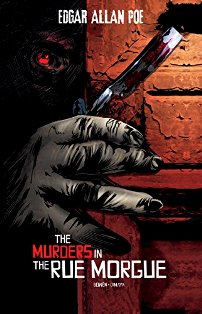
First published back in August of 2013, Raintree’s graphic novel adaptation of Edgar Allan Poe’s classic short story ‘The Murders In The Rue Morgue’ was adapted by Carl Bowen with artwork Emerson Dimaya.
DLS Synopsis:
Paris, 1841. The two of them had met for the first time in a French library. They’d both been reaching for the same rare book, reflecting their shared interest in a thirst for knowledge. They’d struck up a conversation and from that first chance meeting their friendship had blossomed.
He’d introduced himself as Auguste Dupin. He was a man with little money but an incredible mind. Their joint passions saw Dupin soon moving in with his new found friend. Wiling away the evenings in the study together or out on the streets of Paris, conversing on whatever subject took their fancy.
It was one such night when they were out wandering the streets that a blood curdling scream pierced the night sky from within Rue Morgue. The next day the papers were full of the ghastly news about what had taken place in Rue Morgue that night.
Madame L'Espanaye and her daughter had been murdered in their flat. Madame L'Espanaye’s body had been found on the building’s forecourt, her head sliced clean off. Her daughter’s corpse, stuffed up inside the chimney.
One of Dupin’s friends – a bank clerk by the name of Adolphe Le Bon, is quickly arrested. He had been the last one to see the two alive. Furthermore, the local police believe he had enough of a motive – assuming he had been after the four-thousand francs he’d been delivering.
But Dupin isn’t convinced. His friend wasn’t showing any signs of guilt. Dupin believed in his innocence. So much so that he’d convinced the Prefect of Police to let him investigate the matter himself. And hopefully he’d finally get to the bottom of the grisly double murder once and for all…
DLS Review:
It’s probably safe to say that most horror fiends already know Poe’s classic short story of mystery and murder. Even if you’ve not necessarily read Poe’s original, chances are you’ve come across a latter day adaptation – such as with one of the many TV and film adaptations or within inspired works such as the likes of Clive Barker’s ‘New Murders In The Rue Morgue’ (1984).
Here we have the story retold (by writer Carl Bowen) in graphic novel format. And Bowen’s done a damn good job of adapting the tale into this fully illustrated format.
Poe’s original was told through the perspective of an unnamed and wholly undescribed narrator. Of course, in graphic novel format (where the reader gets to visualise everything), Bowen was forced to finally reveal to us what this second individual looks like (although his name is still not disclosed).
The pacing is swift whilst pushing forward with an excellent consistency. There’s no unnecessary panels simply included for padding. Each panel has a purpose – an integral part of the story to tell. Nothing is wasted.
Bowen’s adaptation also sticks incredibly closely to Poe’s original story. There’s no deviance or obvious trimming of the original tale. It’s all in there, but modified so that it can be told in this new format.
That said, Emerson Dimaya’s artwork has (what I’m sure is quite purposefully) avoided showing the bloodier side of the story. There is of course, some splashes of blood, and signs of violence. But it’s all relatively tame in its delivery. Splatters of blood seem lighter than those depicted in Poe’s original. The decapitated body of Madame L'Espanaye is drawn at such an angle that it’s far less bloody than could otherwise have been shown. It’s a recurring theme within the whole graphic novel. But then the publishers are Raintree, who specialise in literature for children and young adults – so keeping the blood and violence relatively tame was undoubtedly part of the publishers remit.
The artwork itself is bold and moderately detailed. Although at times it does seem that Dimaya goes for a sketchier and less defined touch than in other areas of the graphic novel. Indeed, character faces sometimes edge closer to that of a caricature style cartoon than a graphic novel.
Nevertheless, it reads well, with a good solid pacing behind it and decent enough illustrative artwork. And of course, it’s a damn fine story that’s been adapted.
The graphic novel runs for a total of 69 pages (including six pages providing a short biography on Poe’s life, a glossary of terms used, and questions about the story’s telling).
© DLS Reviews






